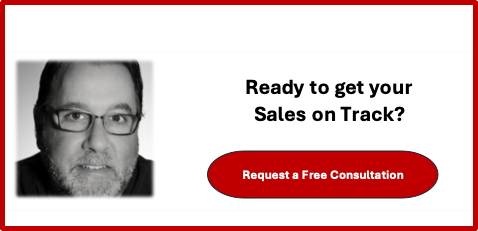It’s midnight. Your recycling bin is overflowing with rejected resumes. Your eyes can barely focus on the letters in front of you — and you have this uneasy feeling that you are about to invest in another candidate who just isn’t going to work out.
This has been a vicious cycle over the past several years, and you find yourself asking yet again,” Why can’t I find the right salespeople?”
You’ve spent an excessive number of hours and are well into six figures in budget dollars hiring, training, firing, and rehiring.
You’re losing credibility in the marketplace because your customers are continually being introduced to new reps. With each salesperson that doesn’t work out, you can feel your employees questioning your leadership and the direction the company is headed.
And this last candidate… they checked every single box. An ideal candidate with a promising start. Industry experience. Excellent references. High performance everywhere they went. You gave them everything they wanted only to discover they weren’t what they appeared to be.
How could you have been so wrong about yet another candidate, a supposed “A-Player” who just couldn’t deliver the level of success they promised in the interview.
Instead of burying yourself in another pile of seemingly perfect resumes, it might be time to take a step back.
Key Article Takeaways:
· Pitfalls that prevent A-players from performing in a new sales environment
· How to lay out a sales roadmap to generate consistent results
· Key sales leadership focus areas that pay dividends
Time to Slow Down to Speed Up
Some organizations seem to have it all figured out: low sales turnover; tremendous growth; happy employees doing what they love.
Sure, when things go right, everyone is happy.
But when issues continuously arise that take your top salespeople away from their outbound calls to chase down problems or they are struggling to know where to focus their effort, there’s likely a more significant issue at hand.
By all means, keep searching for the best and brightest salespeople – the ones you know have the talent and desire to excel in your organization.
But before you get too far in the process, take a step back and examine your sales readiness.
· Are you setting your salespeople up for success right off the bat?
· Are there things you know you could do better but haven’t had the time to fix?
· Are you doing everything you should be to create a sales culture that allows anyone you hire the opportunity to see success?

If you’ve found yourself turning over salespeople one too many times, the problem might not be the candidates.
Yes, poor performers are probably never going to work out. But some of the people that have come and gone might have done better if you optimized your strategy, structure, process, and people to set your whole team up for success.
Strategy:
Getting a new salesperson off on the right foot starts with having a well-thought-out Strategic Sales Plan in place. Leaders need to provide direction rather than counting on their salespeople to instinctively know the best course of action.
A robust strategy should equip salespeople with an understanding of the different types of buyers they’ll encounter, the challenges and objections they’ll face, and how your solution is different from the competition. When done correctly, this becomes the guidance your salespeople establish their individual sales plans upon, which should tightly align with your desired end goal for the entire business.

Structure:
Another pitfall that can derail even the best A-Player is when an organization does not have the proper infrastructure to support its sales efforts. This encompasses a wide range of elements from staff structure to the necessary systems to measure and manage performance.
For example, creating clear lines of accountability for all roles and functions that interface with the customer will bring clarity to performance expectations. This prevents time-consuming distractions and fosters a customer centric culture.
Another area of structure involves the method in which your prospect and customer segments are designated and managed. This provides your customers with a consistent experience and enables your sales resources to be positioned in their areas of strength.
These best practices create a solid platform for your salespeople to work from.
Then, layering on the appropriate systems to capture sales activity, report on key metrics, manage sales pipeline, etc., allows you and your leadership team the critical visibility needed to keep a pulse on how the business is progressing toward its goals.

Process:
The heart of the sales organization is the sales process. When you effectively nail down your sales process, you have essentially bottled a scalable formula for success.
This means if you drop a new member into your Sales Team and have them follow the roadmap you laid out, they can deliver the same consistent results as other team members.
Assess the effectiveness of your sales process by reviewing things like:
● Is my sales process documented with clarity?
● Is my sales pipeline showing good movement?
● Are my salespeople performing consistently?
● Does the Sales Team regularly achieve forecast accuracy?
People:
Even with solid strategy, structure, and processes in place, hands-on sales leadership is the magnet that draws it all together.

As you assess your performance in this area, consider the consistency of your weekly one-on-one sales meetings for individual planning and mutual accountability.
Given the reliance of the salesperson on their sales manager, powerful outcomes are produced when both sides are willing to be accountable to the other.
Another important area to review is the level of value your sales meetings deliver to the team.
Lastly, keep track of how often you participate in sales calls — both in-person and video calls, and how often you are creating powerful learning moments for your reps through these interactions.
Are you struggling to find the time to apply this level of focus?
Do you recognize there are times when you aren’t sure how to confidently lead and develop your salespeople?
These common needs in small to mid-sized businesses were the driver behind my decision to transition my extensive VP Sales background to help top executives on a fractional or interim basis.

How To Get Started
To begin the self-assessment on your readiness for attracting and retaining A-Players in this high-demand market, I invite you to take my 10-question Sales Agility Assessment.
You will get a comprehensive report on your sales organization’s positioning, including helpful insights, actionable tips, and results benchmarking.

If you’d like to have a preliminary discussion about the sales challenges you are facing, please feel welcome to contact me through any of these methods: 413-626-7040 , kdonovan@salesxceleration.com or book a call through my Scheduling Tool
———————————————————————————
I am part of a national group of Senior Sales Leaders who collaborate to share insights like the examples shown in this article. We formed because of our shared passion to help business leaders exponentially grow their revenue.